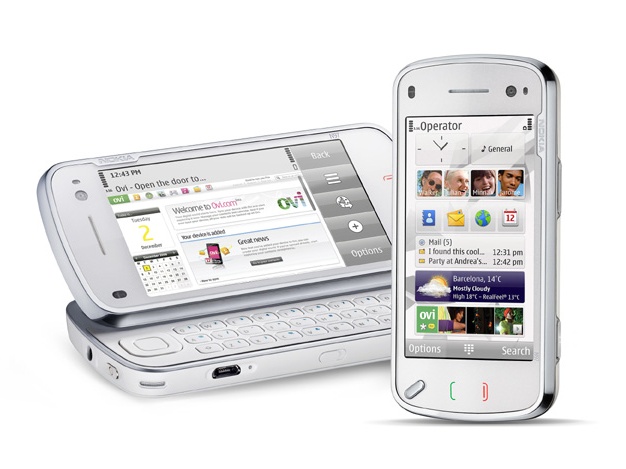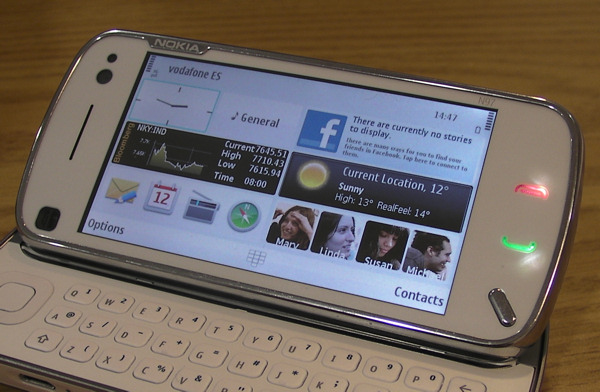Whoa there!
Stop. I know exactly what you're going to say - so I'll get in first.
The Nokia N97:
- is a great example of Nokia "plastic-fantastic" (as Andy Lee would say). Squeeze the plastic back and it creaks a little. Be careless with the plastic touch screen and you've got a nice matte of scratches.
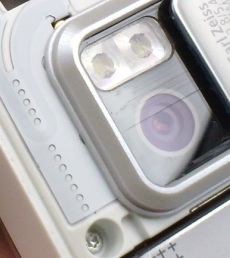 had a couple of poorly designed components for the first few months of its life. Specifically, the camera glass protector (which sat too low and scratched the thing it was supposed to protect) and a badly shielded GPS antenna. Both components are fixable at service centres and have been fixed for all production hardware since about October 2009.
had a couple of poorly designed components for the first few months of its life. Specifically, the camera glass protector (which sat too low and scratched the thing it was supposed to protect) and a badly shielded GPS antenna. Both components are fixable at service centres and have been fixed for all production hardware since about October 2009.
- is underpowered in terms of CPU, RAM and internal (system disk, C:) flash memory. Hit it hard with running apps and something will break. Things will grind away slowly, apps will get closed in the background and if you get download-happy with Nokia-optional 'upgrade' components, you'll run out of room on C: and you'll be facing a backup/re-format/restore cycle to try and recover the situation. This facet of the N97 alone is worth you not recommending it to anyone who's afraid to get their hands dirty with 'tech'.
- has a touch interface that's clearly still first (or maybe second, to be generous) generation. When S60 5th Edition first became available (in the 5800), it was klunky, now it's a lot less klunky and merely a bit inconsistent and a little confusing. And no, the N97 won't get Symbian^3 - I refer you to the bullet point above.
- has a qwerty keyboard that's minimalist at best, with an offset space bar (that you do get used to in seconds, to be fair) and which requires a 'shift' to even get a comma.
- has stereo speakers that are just about the tinniest I've heard - and they're not the loudest either.
Enough evidence to put the N97 away 'where the sun doesn't shine'? Probably. In which case why on earth do I keep coming back to the N97 over and over again? And it's not just me - go ask bloggers like Micky Aldridge, who seems caught in the same loop as me.
We talked a year or so ago on All About Symbian about the Nokia E75 being a great all-rounder, a device which excels at absolutely nothing but which does absolutely everything to a competent degree. This is also how I feel about the N97. There is absolutely nothing it does which is better than every other phone in the world. But there's also (almost) nothing it can't do.
Just to re-iterate, I've had the following brand new top-end smartphones pass through my hands just in the last four months:
- Nokia E72 (tiny 2.4" screen, no Podcast client) - see the AAS review
- Samsung i8910 HD (super hardware but let down by lack of official support, poor battery life - see below - and illegible screen in the sun - ditto) - see the AAS review
- HTC Desire (poorish speaker, poorish battery life, and again illegible in the sun) - see the Phones Show review
- Google Nexus One (as above, but with less HTC-ised software package) - see the Phones Show review
- Sony Ericsson X10 (terrific screen, poor battery life, appalling mono speaker) - see the Phones Show review
- Sony Ericsson Satio (buggy, poor Xenon-integration, cheap plastics. And did I mention it was buggy?) - see the AAS review
- Sony Ericsson Vivaz (poor screen in sunlight, inconsistent interface(s), exposed camera glass, no camera flash) - see the AAS review
- Motorola Milestone (poor keyboard, poor keyboard and, yes, a poor keyboard, ruining the device's USP) - see the Phones Show review
- HTC Legend (screen a little small, Sense UI a bit overwhelming, poor battery cover arrangement, usual OLED in sunlight complaint) - see the Phones Show review
- HTC Hero (screen small again, plasticky, speaker quiet) - see the Phones Show
If the above seems as though I'm being picky, then you'd be right, but remember that I do this for a living and that I picked just as big a list of negatives for the N97 at the top of this article. We're still a long way from the perfect, faultless smartphone.
Balancing the N97's fault list, long though it is, are some unique characteristics, for me at least:
Transflective
For starters, the screen's almost unique among Symbian-powered touchscreen phones in that it's transflective (the only other is the Satio), meaning that you can actually see it in direct sunlight. It's not perfectly clear and it's a long way from iPhone or S60-non-touch contrast, but it's better than the OLED screen of the i8910 HD or the TFTs used by most other touchscreen phones in this ecosystem.

In sunlight, the N97 mini screen (left), without the transflective layer, is distinctly harder to read than the N97's, which has a transflective layer that is able to use some ambient light to reflect back through the LCD elements... Most Nokia/Symbian touchscreen phones don't have this layer.
I was in London this week for a meeting and decided to walk the mile or so each way from the station to the venue as it was a gorgeous sunny day. Using the Samsung i8910 HD, I had extreme difficulty in reading the screen for directions in Google Maps, without having to explicitly seek out shady spots. Turning to the N97, the maps were at least visible.
Hero battery life
The other showstopping problem I had in London was battery life on the i8910 HD. You may remember that I did a similar 'power user's day out' on the Nokia N97 mini last year - and it let me down, running out of steam by early afternoon - patently not good enough. The i8910 HD has the larger 1500mAh battery and (theoretically) power saving OLED screen, but the faster processor and the OS itself seem to eat power and I was down to one bar of battery life by the time I neared home at the end of the day - and I hadn't really pushed the phone too hard.
The Nokia N97 has the same nominal battery capacity as the i8910 HD, 1500mAh, but seems to be significantly more frugal in terms of using this up. I also suspect Nokia's BP-4L cell is more efficient than Samsung's A8 cell and, whatever the N97's other faults, running through batteries isn't one of them. The BP-4L is the same 'hero' battery as used in the E61i, E90, E71, E72, E52 and E55, of course (among others), all of which have superb battery life. And there's the ease of swapping batteries between the N97 and any of the above (I have several in my permanent armoury), which is another distinct attraction.

(For really power-intensive trips, there's also the 3600mAh Mugen battery, but that does make a bit of a brute out of the N97 in terms of form factor!)
FM transmitter
There seems to be some confusion about FM transmitters. This is not, repeat not the same as an FM radio. Almost every phone has the latter. An FM transmitter (only in a handful of smartphones, the N97 being one of them) broadcasts the audio from the phone on a frequency you choose to any FM radios nearby. The main use of this is in-car, where you can play podcasts and music back through your car stereo system without having to fiddle around with cassette adapters, aux sockets, and so on. It's a bit of a legacy feature in some ways - I mean it's an analogue system! - but it's also really, really useful, especially on long journeys.
And no, in answer to what you're thinking, the car behind probably can't pick up your broadcasts - the transmissions only have a range of a couple of metres!
Camera glass protection
As with an FM transmitter, this (somewhat obvious) feature is surprisingly rare - almost every smartphone that you'll be able to think of has an unprotected camera glass - only devices like the Sony Ericsson Satio, Nokia N900, N95, N82, N85 and N86 have mechanical protection. And yes, I know I proved that for most purposes scratches on camera glass didn't make much difference, but there's the more common problem (I've found) - that of fingerprints and general dust and grease accumulating. These do make a difference, yielding obviously blurry photos - yes, it's easy enough to stop and wipe the glass on some clean clothing, but with a mechanical protector the glass stays clean, dry and scratch-free far more easily.
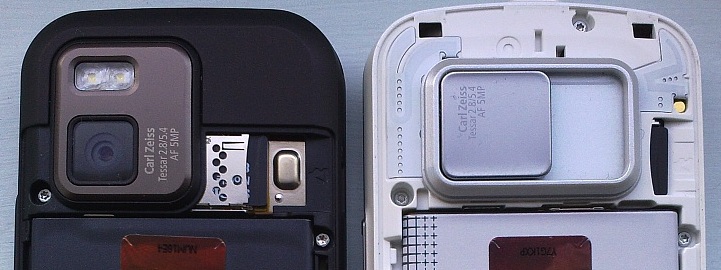
(left) the unprotected camera glass on the N97 mini, (right) the protective/activation slide on the N97
There's also the not-insignificant factor of being able to launch the Camera application by sliding open the camera protector. This is very intuitive and makes the smartphone far more 'camera-like' in this role.
The principle reason most smartphones don't have such protection (/camera-launching capability) is bulk, of course. Adding an extra 2 or 3mm just for the luxury of a little more plastic is a tough design decision - as we saw in this week's launch of the Nokia N8, with bulk being one of the prime reasons why there's no camera glass protection. Ditto for the N97 mini, shown above. Regardless of bulk (ha!), the N97 has this.
32GB mass memory
Although I'll freely admit that 17GB or so of my 32GB is currently free, it's still freeing to know that I can stick almost any file of any size in there, or install any application, no matter how large, or load up many video files, without constantly worrying about running out of space. It's effectively a bottomless bucket.
There aren't many smartphones with this much internal storage - I can only think of the Nokia X6 32GB and the iPhone 32GB as competitors in terms of space - and neither of those has a microSD card slot to add another 32GB! So I can walk around with 64GB of file system in my pocket - which is pretty impressive, still.
QWERTY keyboard
Having applied my own metrics to the various Symbian smartphone QWERTY keyboards in the past, the N97 came out pretty badly - numerically. Principally this was down to the relatively few 'extra' keys and lack of key travel, but the numbers don't really do it justice. The N97's QWERTY keypad isn't a patch on the E90's for example, but it's actually quite usable. Now that the v20 firmware added 'long press' functionality in, for easier access to the 'function' characters, most N97 users will tell you that the restricted key set isn't a problem in real life.

Above all though, the salient point is that the N97 has a physical QWERTY keyboard. The best way to appreciate having one (or to work out if you need one) is to go a week with a QWERTY-equipped device and then a week with a T9-keypad phone (and then a week with a 'virtual' QWERTY touchscreen device). The combination of a real keyboard and a full-screen display (i.e. you don't have to sacrifice most of your display to showing a virtual keyboard) can't be beaten, in my opinion. The iPhone's virtual keyboard intelligence arguably comes close for general text but then the physical keyboard streaks away once you start hitting names, places and irregular text.
Angled display
The patented N97 alloy hinge is unique in automatically and quickly presenting the full screen at an angle, for easier viewing. It's not easier for general text entry, mind you - a flat slider would work just as well. But when it comes to having media or content displayed on your desk or table - for example, watching a video - having the screen propped up internally is a massively better solution than with the likes of the candy bar iPhone/i8910/Nexus One/HD2, which all have to be propped up with a book or toast rack (or similar!)
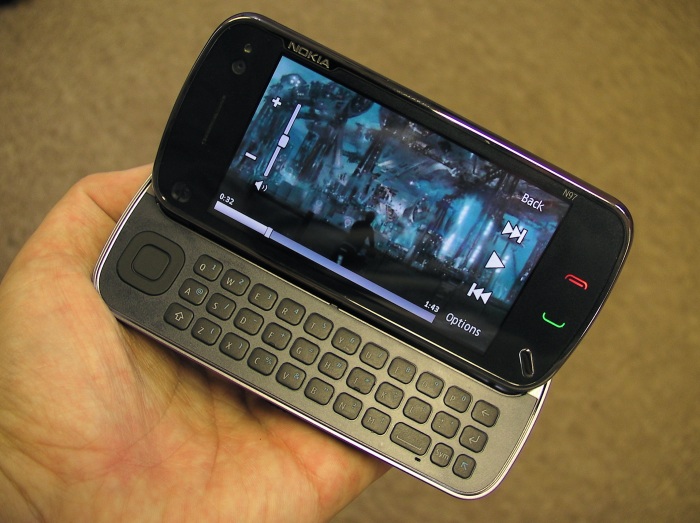
Great camera
For still photos, the N97 has essentially the same great 5 megapixel Carl Zeiss-lensed camera as the original N95. But this isn't a complaint. The aperture is large enough to gather light for most outdoor situations and there's dual LED for impulse shots indoors or for using as a video light.
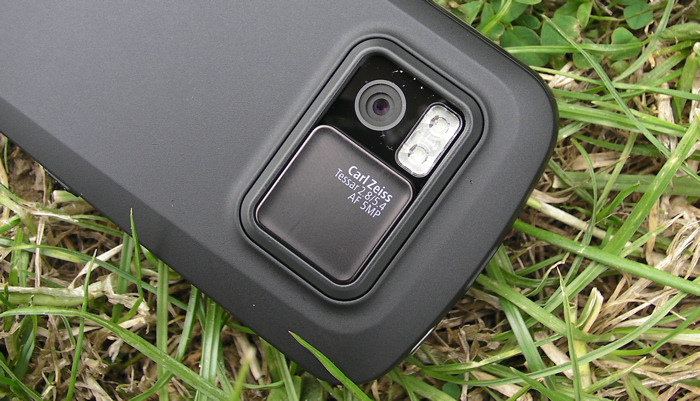
In fact, the number of people standing up and showing off their N97-shot masterpieces has risen sharply in recent months. Compare these shots to photos taken on any non-Nokia five megapixel cameras and I think you'll be surprised.
It's a Nokia
This sounds a bit obvious, but in the wider smartphone world, each platform and manufacturer has its own pros and cons. In the Nokia world, we're talking about Ovi Maps, principally, with free voice guided sat nav, for walking or driving, anywhere in the world, forever. And recent versions of Ovi Maps have included better and better points of interest and place finding, so it's turning into quite a big deal.
Also, by going Nokia, you get regular firmware updates (much needed in this case, admittedly), and a host of extras, nearly all of them free, from Beta Labs and from the main Ovi Store.
The nine huge plus points above have hopefully made you pause and think - if only for a minute or two. There's simply nothing else in the world that can match all (or even most) of the above. Which means that if even (say) 7 of the 9 attributes are vital to what you want from a smartphone then only be achieved with the 'love it or hate it, you can't ignore it' Nokia N97....
Living with the N97 is rarely trouble-free and ultimately limited in terms of trying to do any one task really well. But I still maintain that, with a little care and attention, the N97 can do more for me than anything else. Pitched originally as a multimedia flagship by Nokia (and priced accordingly), the title of 'consummate all rounder' seems to work best these days - there's literally nothing it can't attempt.
Steve Litchfield, All About Symbian, 30th April 2010
